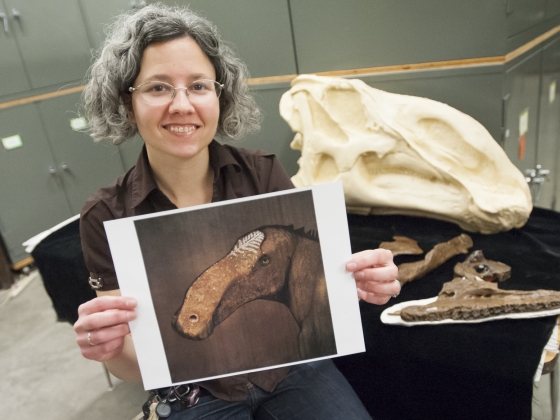Paleontologist Elizabeth Freedman Fowler Discovers New Hadrosaur Species is a Dinosaur Missing Link

Making sense of dinosaur fossils is hard (I’m assuming. I don’t have nearly the scientific prowess to ever set foot near dinosaur bones except to look at them and go “OOOH!”), but sometimes the stars align and scientists have a puzzle piece fall gloriously into place. That’s what happened recently for paleontologist Elizabeth Freedman Fowler.
Back in 2007, Fowler (who works out of Montana State University) discovered fossils from a Probrachylophosaurus bergei, a hadrosaur – you know, the dinosaurs that have the duck bills and the crests on their heads – herbivores that roamed the Earth, mostly on their hind legs, during the late Cretaceous period. After studying and determining the age of these fossils, which included a small crest on the skull, Fowler realized that the skull fit nicely between the crest-less skull of the older Acristavus and later hadrosaur skulls that have large, flat, paddle-shaped crests covering the top, back portion, which paleontologists now call Brachylophosaurus.
The Acristavus was around 81 million years ago. Two million years later, the Probrachylophosaurus bergei appeared, having evolved small crests on their heads. 1 1/2 Million years after that, we had the evolution of the Brachylophosaurus, with which we’re the most familiar.
It’s pretty cool when a discovery is made that ties things together as neatly as that; and as Fowler says in an MSU press release, “It is a perfect example of evolution within a single lineage of dinosaurs over millions of years.”
If you want to find out more about this awesome work (because who doesn’t love dinosaurs?!), you can check out the full paper was written by Fowler and her mentor, MSU paleontologist Jack Horner over at PLOS One.
(via Gizmodo; Image via Montana State University)
—Please make note of The Mary Sue’s general comment policy.—
Do you follow The Mary Sue on Twitter, Facebook, Tumblr, Pinterest, & Google +?
Have a tip we should know? [email protected]